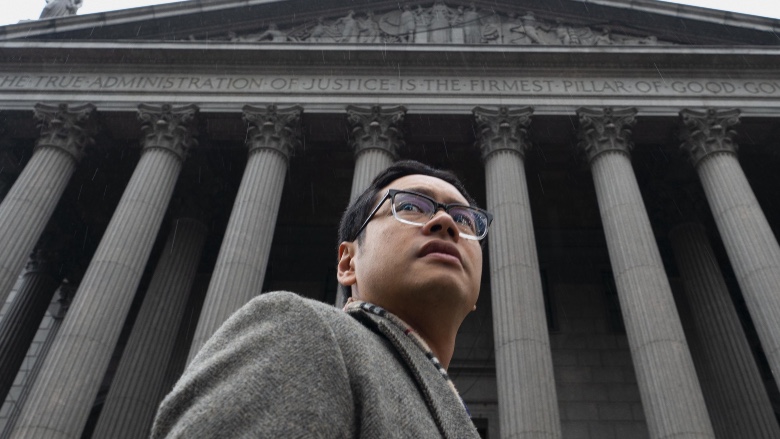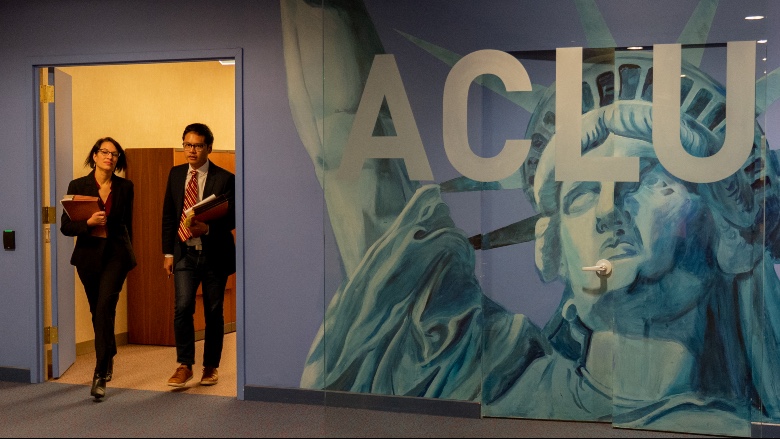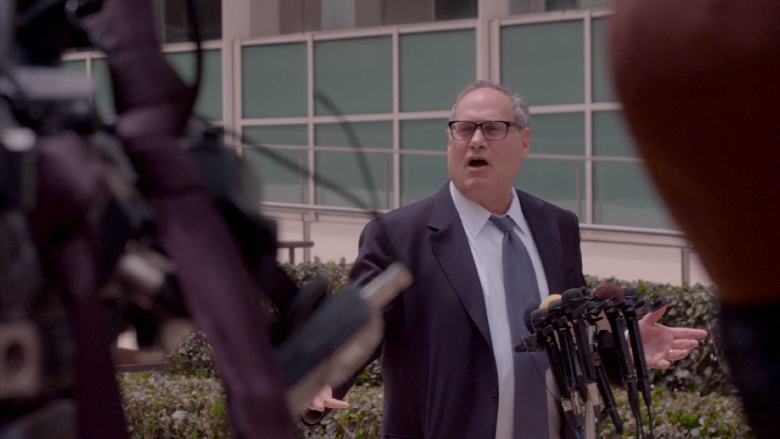
It was January of 2017 and then-President Trump tweeted out — to the shock of many and the delight of others — that he was instituting a “Muslim Ban” at United States entry points. As they have been doing for 100+ years, lawyers from the American Civil Liberties Union (ACLU) quickly took him to court. By the late hours of that evening, they had obtained a court order from a judge in Brooklyn, barring enforcement of the ban for the time being, with the ACLU lawyer pumping his fist in victory in from of the TV cameras and the impromptu crowd that had amassed.
And a documentary filmmaker was there to film it.
We now know this initial tiff set up what would become a four-year long, brass tacks, in the dirt, fight between the administration and civil rights lawyers. It also set up almost equally as long a journey by a group of intrepid, probing filmmakers to document these battles. The product is the stupendous Magnolia Pictures documentary, The Fight¸ which premiered at last year’s Sundance Film Festival and won a special Jury prize. And though we all know the ultimate outcome of the “Muslim Ban” fights –the U.S. Supreme Court would eventually uphold a modified version of the prohibition — this makes the film in some ways more dramatically compelling. As the setbacks and defeats pile up alongside the victories, the four groups of attorneys we follow, thanks to clever and highly effective editing by The Fight’s editing team, becomes even more gripping.

That team is comprised of The Fight‘s Co-Director Eli Despres, his partner Kim Roberts, and Greg Finton (He Named Me Malala, Waiting for ‘Superman’). Below the Line had a chance to speak with the trio last month to ask about the incredible journey they experienced and recorded for posterity, how they pieced it all together, and the challenges of editing documentaries.
“The opening scene of the movie is set seven days after the Trump inauguration,” Despres explained. “[Co-Director] Elyse Steinberg was actually there on the steps of the courthouse when [the ACLU attorney] came out, his fist raised in triumph. From there, she said, ‘This is where we have to be, this is the story of the next four years.’ She kicked down the door of our office and wiped our whiteboard of ideas and wrote ‘The Fight,’ this is what we are doing. From there, it was about gaining the trust of the ACLU,” he recounted.
“And there was a new fight every week, it felt like,” Roberts offered.
Indeed, as Roberts points out, it turns out The Fight had a lot of ground to cover. The result of their efforts led them to eventually follow four sets of attorneys fighting four distinct battles against the administration. In addition to the aforementioned lawyers fighting the Muslim Ban (and who eventually switch over to fighting the border separation policies), another group battles against Trump’s ban on transgender service members, a third takes on new laws restricting voting rights and, eventually, Trump’s attempt to not count immigrants for purposes of the 2020 Census. The last group take on increasing abortion restrictions, particularly in the nation’s immigration system.
“There was an editing challenge from the beginning,” Roberts told us, “In trying to convey that there are only four stories, you’re following this large institution. At one point, there was this feeling in the first act that you had no idea how many stories you would be watching. So we had to craft basically a title sequence to signal to the audience: ‘These are the stories we will be following.’”

As Despres described it, “The editing decision here was to establish the rules of the road for the movie.” Remarkably, this editing decision did not come until a screening.

Even with the rules set in place, with so much material, the editing decisions presented to the filmmakers are palpable. “There was a lot of trial and error within the process, like in all documentary filmmaking,” explained Finton. “We were actually following a lot more than four stories to begin with, and by the time I came on, Eli had whittled it down to about six. I never thought the [census case] story to come into the case because we were expecting a different outcome, but it quickly went from a ‘C-story’ to a topline story. You have to go back and relook at your footage and that is what we did, but that is what’s so great about verite filmmaking.”
Another twist in The Fight is that it depicts real-life courtroom arguments in some of the nation’s top courts, including the Supreme Court, where cameras are not typically allowed. “it was a fun challenge,” Despres explained. “My best editing moments come in solving these types of problems. So we used animation, where we could use whatever lens and placement we wanted to. In terms of editing, we can get the build-up and quickly cut to the reaction, which makes for a delightful sequence for audiences. These are opportunities to do creative things structurally,” he said.
“The freedom to intercut the stories gave us the ability to have different cases carry different parts of the narrative act at different times,” Finton explained. In that way, The Fight manages to keep the tension and suspense while following these very human stories behind the lawyers themselves. “This is why I love editing documentaries,” Finton said, as Roberts laughed when we asked her how much more footage she ends up with as compared to fiction filmmaking.

“It’s a pain in the butt, but you rely on the experience of being able to glance at a lot of footage quickly and figure out very quickly where the arc of the story is,” Despres added. “These are ridiculous amounts of footage,” Roberts agreed, offering, “Even if the editors don’t get the credit, the editors are in fact writing the story by the decisions they make. The exciting part in documentary is finding and in essence writing the story in how you put it together.”
And while many of these cases are familiar to most of us from reading the news, the legal questions are still fairly complex. This presented another editing challenge — how to explain things to the audience?

“Trial and error,” Despres explained. “Audiences love to feel like experts or insiders, but you have 90 minutes. In the end our approach was to figure the emotional beats and get those in order, and then add information to ground the audience and introduce nuance until it felt like they were there for the story.” His partner, Roberts, added: “You keep trying to dial it back to the minimum information people need to understand.”
As The Fight progresses, it becomes about much more than just the legal battles. The long hours, the defeats, the high stakes, all take a visible toll in the personal lives of these dedicated warriors. “We have more opportunity to solve story telling problems and create devices in documentary, which is really exciting as an editor,” said Finton, referring to this twist, and the challenge of not having cameras in the courtroom.
“All of us are drawn to character-driven stories, so it made sense to us to tell the stories through their experiences of it,” explained Despres. “It was inspiring to be around them—they are superheroes.” Finton agreed, adding, “It felt like such an inspirational story about people actually doing something.” Despres loved the actual lawyers so much, he joked, “We would have been in the bathroom, if they had let us.”
While recording these legal resistances to Trump was critical, “I’m hoping we can cure ourselves of our addiction to trauma and stress,” Despres concluded.
But if you need a little “fix” for Trump anxiety — and a tremendously inspiring, pitch-perfect film — check out The Fight via Digital HD and On Demand.
All photos courtesy of Magnolia Pictures, except where noted.





